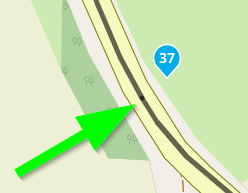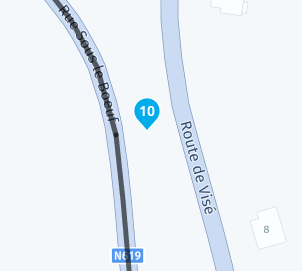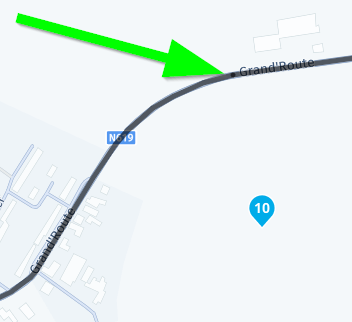Waypoint saltato in un percorso.
-
Ciao a tutti.
Mi è capitato anche recentemente di aver saltato mentre ero in viaggio con la mia GoldWing un waypoint e, ovviamente, il navigatore della moto mi voleva far ritornare al punto superato. Chiedo se tra le possibilità offerte da MRA c'è anche quella di fare in modo che saltato il waypoint (magari dopo aver percorso qualche chilometro) lo elimini automaticamente. Lo chiedo perchè ho notato che se utilizzo Android Car Play (che però non uso mai) tale opportunità esiste.
Grazie. -
Ciao a tutti.
Mi è capitato anche recentemente di aver saltato mentre ero in viaggio con la mia GoldWing un waypoint e, ovviamente, il navigatore della moto mi voleva far ritornare al punto superato. Chiedo se tra le possibilità offerte da MRA c'è anche quella di fare in modo che saltato il waypoint (magari dopo aver percorso qualche chilometro) lo elimini automaticamente. Lo chiedo perchè ho notato che se utilizzo Android Car Play (che però non uso mai) tale opportunità esiste.
Grazie.@Massimo-Campanardi Non è facile da capire.
Se si imposta un punto di percorso come punto di sagomatura, è necessario che l'errore di questi punti avvenga in un raggio maggiore. Anche una Vorbeifahrt in un'entrata più piccola viene considerata come un'aggiunta di un punto.Se si imposta un punto di rotta come punto di passaggio, l'aggiornamento dei punti viene effettuato solo in un piccolo raggio! Inoltre, un viaggio in un'area più ampia non è sufficiente a garantire l'esecuzione di un punticino!
Se anche voi non vi siete soffermati su un singolo punto, allora la navigazione si interromperà, in modo che voi possiate essere sicuri di averla raggiunta.
Se non si trova esattamente sulla strada, ma solo su una strada diversa, è possibile passare da un punto all'altro, perché non si può superare il punto. Dann versucht die Navigation dich ewig dorthin zu leiten.
Se si desidera fare una tale riflessione, si può cliccare sull'icona del punto di navigazione a destra e a sinistra, in modo da poter aprire il punto di navigazione.
‐---------------------‐-
This is not easy to answer.
If you set a route point as a shaping point, then reaching this point within a large radius is accepted. In other words, a pass at some distance is regarded as reaching the point.If you set a route point as a via point, then reaching this point is only accepted within a small radius! In other words, passing a point some distance away does NOT count as reaching the point!
If you do not drive exactly to such a point, the navigation will take you back until you have reached it safely.
If you do not hit the road exactly when setting the via point - but a little off the road - it could happen that you cannot drive over the point at all. The navigation system will then try to guide you there forever.
If you notice something like this, you can click on the waypoint icon at the top right of the navigation window to skip this waypoint.
-
@Massimo-Campanardi Non è facile da capire.
Se si imposta un punto di percorso come punto di sagomatura, è necessario che l'errore di questi punti avvenga in un raggio maggiore. Anche una Vorbeifahrt in un'entrata più piccola viene considerata come un'aggiunta di un punto.Se si imposta un punto di rotta come punto di passaggio, l'aggiornamento dei punti viene effettuato solo in un piccolo raggio! Inoltre, un viaggio in un'area più ampia non è sufficiente a garantire l'esecuzione di un punticino!
Se anche voi non vi siete soffermati su un singolo punto, allora la navigazione si interromperà, in modo che voi possiate essere sicuri di averla raggiunta.
Se non si trova esattamente sulla strada, ma solo su una strada diversa, è possibile passare da un punto all'altro, perché non si può superare il punto. Dann versucht die Navigation dich ewig dorthin zu leiten.
Se si desidera fare una tale riflessione, si può cliccare sull'icona del punto di navigazione a destra e a sinistra, in modo da poter aprire il punto di navigazione.
‐---------------------‐-
This is not easy to answer.
If you set a route point as a shaping point, then reaching this point within a large radius is accepted. In other words, a pass at some distance is regarded as reaching the point.If you set a route point as a via point, then reaching this point is only accepted within a small radius! In other words, passing a point some distance away does NOT count as reaching the point!
If you do not drive exactly to such a point, the navigation will take you back until you have reached it safely.
If you do not hit the road exactly when setting the via point - but a little off the road - it could happen that you cannot drive over the point at all. The navigation system will then try to guide you there forever.
If you notice something like this, you can click on the waypoint icon at the top right of the navigation window to skip this waypoint.
@Guzzist, I am not aware of a difference in distance for via and shaping points for them to be considered "hit", or reached.
If you do not hit the road exactly when setting the via point - but a little off the road - it could happen that you cannot drive over the point at all.
MRA is a little bit smarter than that
 Each route point has a second point projected to a road. Consider the little black dots in the planner, like this:
Each route point has a second point projected to a road. Consider the little black dots in the planner, like this:
That position is used for being "hit" or not and not the waypoint itself.
Where it get's tricky is this:
It can be a matter of millimeters to have WP10 in this example on the other road, which alters your route.
So in reality the method is quite forgiving concerning the placement of waypoints:
but in certain circumstances strange things can happen. To prevent that of course exact placement is best practise, but I also feel sometimes it is stressed a bit too much

-
@Guzzist, I am not aware of a difference in distance for via and shaping points for them to be considered "hit", or reached.
If you do not hit the road exactly when setting the via point - but a little off the road - it could happen that you cannot drive over the point at all.
MRA is a little bit smarter than that
 Each route point has a second point projected to a road. Consider the little black dots in the planner, like this:
Each route point has a second point projected to a road. Consider the little black dots in the planner, like this:
That position is used for being "hit" or not and not the waypoint itself.
Where it get's tricky is this:
It can be a matter of millimeters to have WP10 in this example on the other road, which alters your route.
So in reality the method is quite forgiving concerning the placement of waypoints:
but in certain circumstances strange things can happen. To prevent that of course exact placement is best practise, but I also feel sometimes it is stressed a bit too much

@Con-Hennekens I tried to explain easy. But thank you, I learned again some expert knowledge

